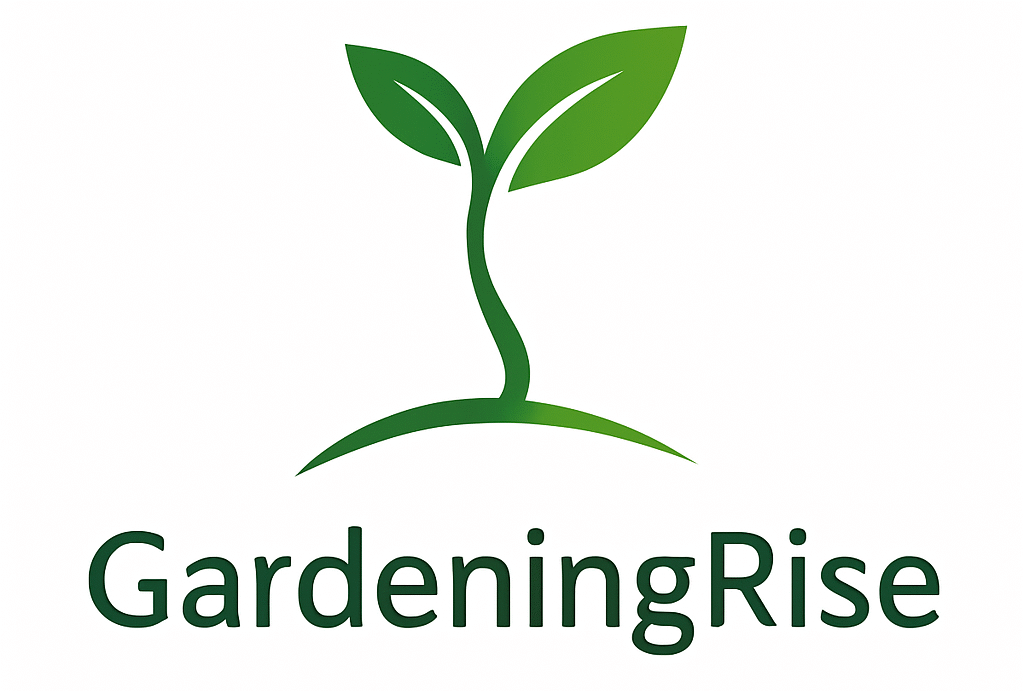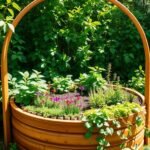Got a forgotten spot in your yard that could use some life? Imagine turning that awkward area into a lush, productive space bursting with herbs, veggies, or flowers. Compact growing solutions let you grow more in less room—perfect for patios, balconies, or tight corners.
Why choose this style? These setups offer better soil control and easier access to plants. Their elevated design reduces bending, while smart layouts—like square-foot gardening—let you grow 16 carrots or 9 spinach plants in one square foot. Plus, they drain faster than traditional plots, protecting roots during heavy rains.
Urban dwellers and small-yard owners love how a 4×6-foot bed balances planting space with reachability. Whether you’re growing kale or cosmos, you’ll find tips here to maximize your harvest. Ready to start? Our guide on how to build a raised bed walks you through creating your own thriving corner oasis.
Don’t let limited room stop you. With smart design and the right location, even tricky spots can become your most productive growing areas. Let’s transform those unused nooks together!
Introduction to Raised Garden Beds
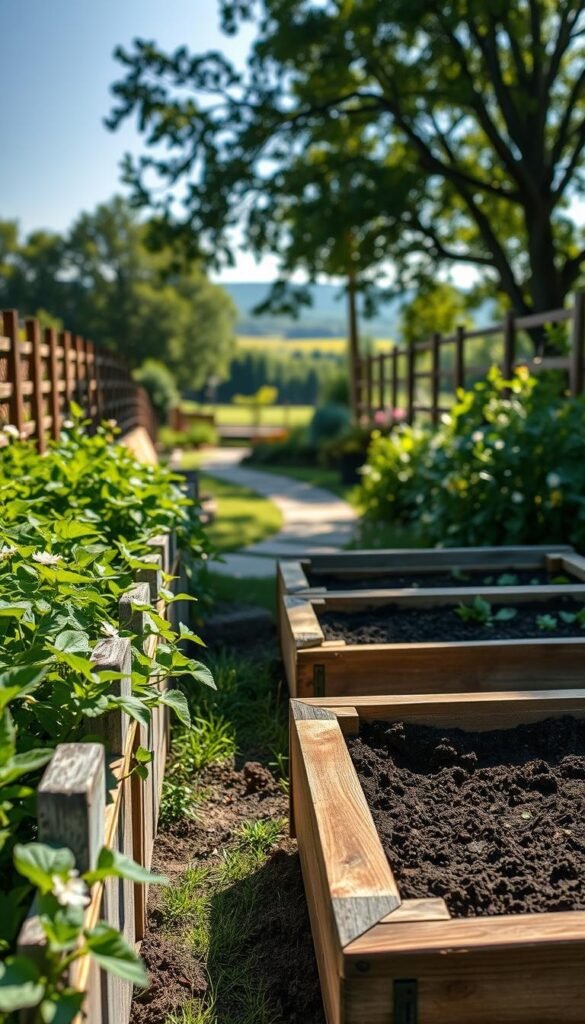
Struggling with poor soil or limited space? Raised beds offer a fresh start for growing your favorite plants. Unlike traditional plots, these elevated systems let you bypass rocky or clay-heavy earth entirely. You create the perfect environment for roots to thrive.
Why do gardeners love these setups? Complete control. You choose every component of your soil mix – no more guessing if local dirt has enough nutrients. This means happier tomatoes, crispier lettuce, and herbs bursting with flavor. Your plants get exactly what they need from day one.
Here’s how they outperform in-ground plots:
| Feature | In-Ground | Raised Beds |
|---|---|---|
| Soil Quality | Depends on location | Custom blends |
| Drainage | Variable | Consistent |
| Accessibility | Bending required | Waist-high options |
| First Harvest | Late spring | 2-3 weeks earlier |
Early birds win! These structures warm faster in spring sunlight. Plant cool-weather crops sooner and enjoy fresh greens while neighbors wait for their ground to thaw. Less kneeling means more comfortable tending – your back will thank you.
Whether you’re growing salad fixings or heirloom carrots, a raised garden bed turns challenging spaces into food-producing powerhouses. Transform that stubborn patch of ground into your most productive growing area yet.
Understanding the Benefits of Raised Garden Beds
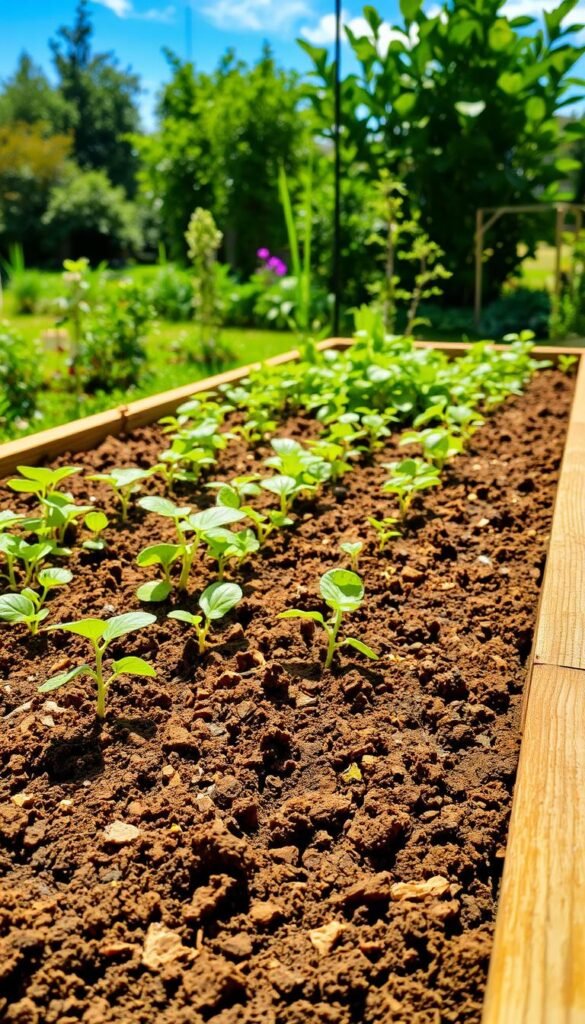
What makes these planting systems stand out from traditional methods? The secret lies in their ability to solve common gardening challenges while boosting your plant’s performance. Let’s explore how they create ideal conditions for your greens.
Improved Soil and Drainage
Say goodbye to soggy roots! Elevated planters let water flow freely through loose, nutrient-rich soil. Unlike compacted ground, your plants’ roots get perfect moisture balance – enough to drink, never drowning. Mix compost and perlite to create a fluffy texture that supports vigorous growth.
Extended Growing Season and Easy Maintenance
These structures act like solar panels, warming soil faster in spring. Start planting lettuce weeks before in-ground plots thaw. Come fall, harvest carrots long after frost nips at ground-level crops.
Access all plants without stepping on soil – no more compressed earth. Spend less time weeding thanks to clear boundaries that stop invasive grasses. Pair with a smart square-foot gardening layout to organize crops efficiently.
Your garden becomes a low-effort, high-reward system. Healthier plants mean fewer pests and bigger harvests. Whether growing snap peas or zinnias, you’ll love how these beds simplify your routine while delivering stunning results.
Corner Raised Garden Beds: Tucking Greens into Cozy Nooks
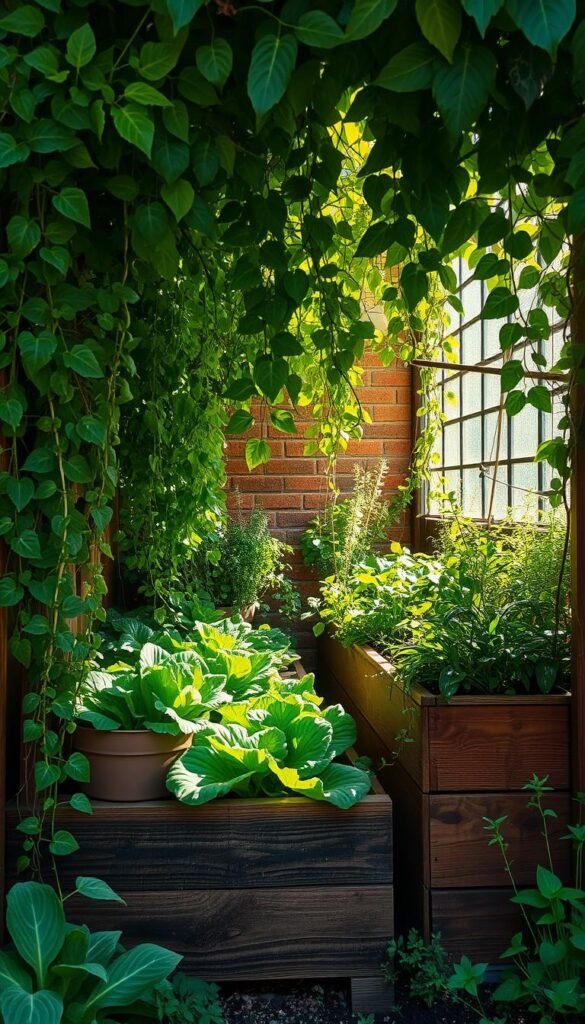
Ever noticed those empty areas where two fences meet? These overlooked spots hold hidden potential for growing fresh produce. Raised beds designed for corners transform dead zones into thriving plant habitats. Their angular shape hugs boundaries while creating a focal point in your outdoor space.
Natural structures like walls become allies in these setups. They shield plants from harsh winds and bounce sunlight to extend warmth into cooler evenings. This creates ideal conditions for heat-loving herbs like basil or delicate greens like butter lettuce.
| Feature | Traditional Beds | Corner Beds |
|---|---|---|
| Shape | Rectangular | Triangular/L-shaped |
| Space Use | 78% efficiency | 94% efficiency |
| Wind Protection | Limited | Built-in barriers |
| Harvest Access | Single side | Two or three sides |
Working in tight spaces has unexpected perks. You’ll water and weed faster since everything stays within arm’s reach. Try pairing tall plants like pole beans with low-growers like radishes – the vertical contrast looks striking against adjoining walls.
For maximum impact, explore creative corner garden ideas that blend function with style. Even a 3×3-foot area can yield 15+ vegetable varieties through smart layering and companion planting.
Selecting the Best Materials for Your Raised Beds
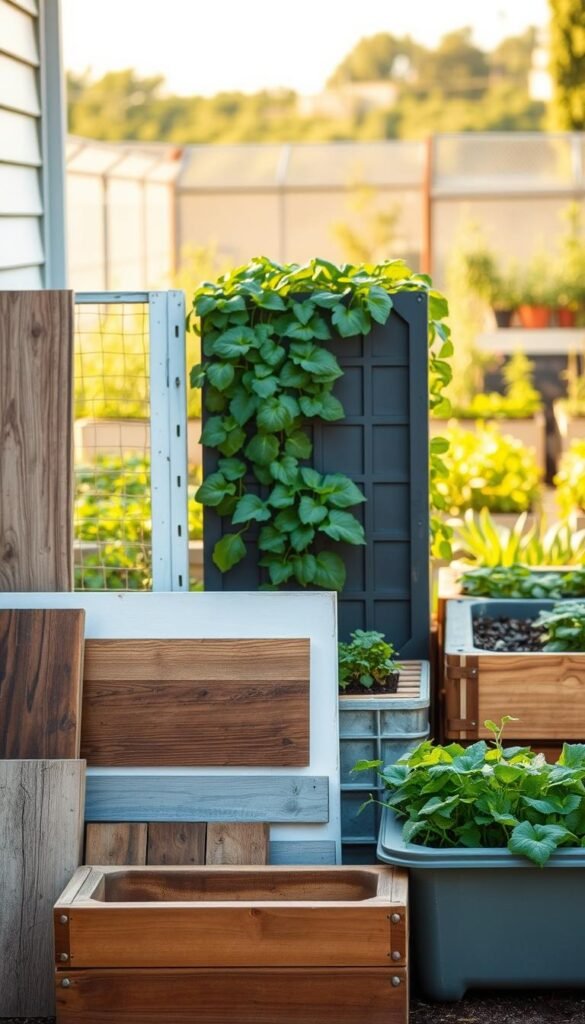
Choosing the right foundation for your planting area makes all the difference. Materials shape your garden’s look, longevity, and maintenance needs. Let’s break down three top options that balance practicality with visual appeal.
Wood vs. Metal vs. Concrete
Wooden raised beds bring natural warmth to outdoor spaces. Cedar stands out for resisting rot without chemical treatments. Though prices have climbed, its 15-20 year lifespan justifies the cost for many gardeners. Pine costs less but needs replacement every 5-7 years.
Galvanized steel offers sleek lines and unmatched durability. These beds withstand harsh weather while maintaining their shape. Perfect for modern designs, they’re ideal if you prioritize low upkeep over initial expense.
Cinder blocks shine in building custom layouts. Stack them like LEGO bricks to create angled planters that hug walls or fences. No tools required! Their porous nature helps regulate soil moisture, though they can heat up in direct sun.
| Material | Lifespan | Maintenance | Best For |
|---|---|---|---|
| Cedar | 15+ years | None | Organic aesthetics |
| Steel | 25+ years | Occasional rinsing | Urban gardens |
| Cinder Blocks | Permanent | Weed removal | DIY shapes |
Consider your climate and gardening goals. A budget-friendly raised bed using cinder blocks might suit a sunny patio, while cedar could better match a shaded cottage garden. Mix materials for visual interest – try steel corners with wooden sides!
Planning Your Garden Layout for Optimal Space Use
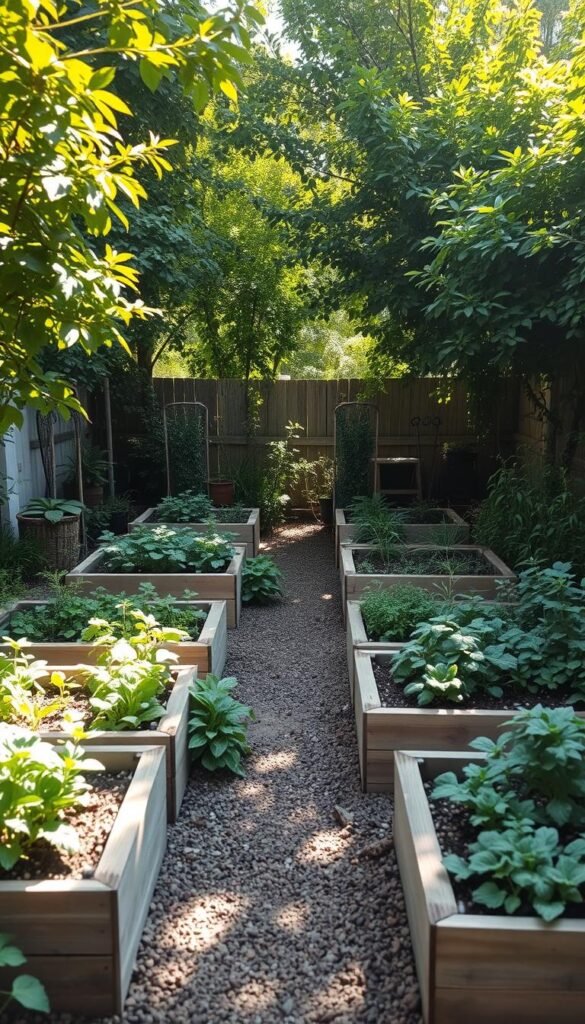
Turn your overlooked corners into productive growing zones by mapping sunlight patterns first. Track how light moves across your space for 2-3 days. Morning sun might hit one wall while afternoon rays warm the opposite side. These microclimates let you match plants to their ideal conditions.
Maximizing Corners and Vertical Surfaces
Tall crops like pole beans thrive near walls that reflect heat. Place shorter herbs or lettuces where they’ll avoid shade. A trellis-mounted planter adds growing area without stealing floor space – perfect for strawberries or trailing flowers.
| Feature | Traditional Layout | Corner Layout |
|---|---|---|
| Access Points | 1-2 sides | 3 sides |
| Vertical Use | Limited | Wall planters + trellises |
| Light Adaptation | Fixed zones | Multi-directional |
| Seasonal Flexibility | Low | High |
Leave 18-24 inches between your bed and permanent structures. This gap lets you reach plants easily and prevents moisture damage to fences. Rotate crops annually – swap leafy greens with root veggies to keep soil nutrients balanced.
Your plans should address summer shade shifts. A maple tree that’s bare in spring might block July sun. Sketch potential shadows at different times to avoid surprises. Pair early-season radishes with late-blooming nasturtiums for year-round color and harvests.
Step-by-Step Guide to Building Your Raised Garden Bed
Ready to roll up your sleeves? Building a sturdy planting area requires smart planning and the right approach. Let’s break down the process into manageable steps that save time and frustration.
Essential Tools and Smart Assembly
Start with these must-haves: a drill, measuring tape, and level. For angled corners, a miter saw helps create precise cuts. Hand tools like clamps hold pieces steady while you work – especially useful for tight spaces.
| Essential Tools | Optional Upgrades | Purpose |
|---|---|---|
| Cordless drill | Pocket hole jig | Secure joints |
| Speed square | Router | Smooth edges |
| Clamps | Laser level | Perfect alignment |
Savvy Construction Strategies
Follow the “worst first” rule: tackle tricky angles before assembling straight sections. This prevents rushed fixes later. Measure your car’s interior before buying lumber – an 8-foot board won’t fit in a compact sedan!
Three budget-friendly tips:
- Check hardware stores for dented metal sheets (50% off)
- Use cinder blocks as temporary corner supports
- Buy soil in bulk during fall sales
Make sure to dry-fit all pieces before fastening. A 5-minute test fit can prevent hours of rework. With careful planning, you’ll create a durable bed that lasts seasons, not just weeks.
Preparing Your Soil for a Successful Garden
The secret to thriving plants starts beneath the surface. Your raised bed needs a custom soil blend that feeds roots while letting water flow freely. Mix three equal parts: nutrient-rich topsoil, compost for microbes, and coarse sand or perlite for drainage. This trio creates the fluffy texture plants crave.
Start with a bottom layer of gravel or broken clay pots. This base prevents water pooling in corners where walls meet. Aim for 2-3 inches of chunky material – enough to protect roots during heavy rains but not so deep it steals growing space.
| Soil Component | Purpose | Ideal Ratio |
|---|---|---|
| Topsoil | Nutrient base | 40% |
| Compost | Microbes & fertility | 30% |
| Perlite | Drainage | 30% |
Depth matters! Leafy greens thrive in 6-inch layers, while carrots need 12+ inches. Fill your bed slightly higher than needed – fresh garden soil settles up to 20% after watering. Check corners weekly; add more mix if dips form near walls.
Test your blend before planting. Kits from local nurseries measure pH and key nutrients. Most veggies prefer slightly acidic soil (6.0-6.8). Adjust with lime to raise pH or sulfur to lower it. Your plants will reward you with vigorous growth!
Watering and Maintenance Tips for Your Raised Garden
Keeping your plants happy starts with smart hydration habits. Unlike traditional plots, raised beds drain faster and lose moisture quicker – especially in windy spots. Check soil daily during the first three weeks after planting. Your pinky finger makes a perfect moisture gauge: if the top inch feels dry, it’s time to water.
New seeds demand extra care. They need constant dampness for 5-21 days to sprout. Use a gentle spray bottle or drip irrigation systems to avoid washing them away. Once established, most veggies thrive with 1 inch of water weekly – but check corners first. Wind and reflected heat dry these areas fastest.
| Plant Stage | Water Frequency | Key Signs |
|---|---|---|
| Seeds | 2x daily | Soil surface moist |
| Seedlings | Daily | Leaves perky |
| Mature Plants | 2-3x weekly | Top 2″ dry |
Save hours with these tips: mulch with straw to lock in moisture, group thirsty plants together, and water before 10 AM. Pair these strategies with square-foot gardening layouts to simplify care. Your plants will reward you with lush growth all season!
Incorporating Companion Planting and Crop Rotation
Have you considered pairing vibrant blooms with your veggies? This dynamic duo creates living ecosystems where plants protect and nourish each other. Strategic combinations reduce pests naturally while boosting yields in your raised beds.
Planting Vegetables and Flowers Together
Bright marigolds do more than look pretty – their roots repel nematodes that attack tomato roots. Nasturtiums act as trap crops, luring aphids away from your kale. These partnerships mean less work for you and safer food for your table.
Compact layouts make it easy to track what works. Try this winning trio:
- Basil + peppers + calendula (improves flavor)
- Carrots + chives + cosmos (deters carrot flies)
- Lettuce + pansies + garlic (slugs hate this mix)
Many people don’t realize how flowers attract pollinators. Alyssum brings hoverflies that eat thrips, while sunflowers draw bees to squash blossoms. For proven combinations, explore these companion plant pairings that thrive in small spaces.
Rotate crops yearly by dividing your bed into zones. Move heavy feeders like corn to new sections each season. This prevents soil exhaustion and keeps your raised beds productive for years.
Inspiring Garden Aesthetics for Cozy Corners
Transform overlooked spaces into living art with smart design choices that marry form and function. Your planting area becomes a canvas where practicality meets beauty, turning tight spots into eye-catching displays.
Creative Designs and Arrangements
Play with curves and levels to match your space’s natural flow. A tiered bed creates depth, while staggered plants on each side add drama. Mix feathery dill with bold Swiss chard leaves for texture contrast that dances in the breeze.
Integrating Art with Functionality
Turn everyday items into showstoppers – repaint old ladders as vertical herb racks or arrange mosaic stones along edges. Edible flowers like pansies double as decor and salad toppings. Use colored mulch to outline paths, guiding the eye through your green sanctuary.
This thoughtfully designed place becomes your private escape. Morning sunlight filters through tomato vines as you sip coffee beside your thriving raised garden. Every corner tells a story, blending harvests with harmony.
